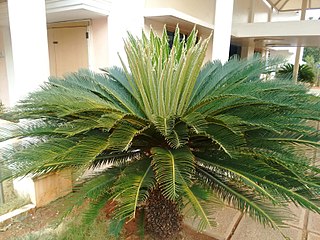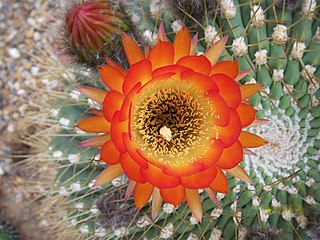
Cycas is a genus of cycad, and the only genus in the family Cycadaceae. About 113 species are accepted, which are native to the Indo-Pacific, East Africa and Madagascar. Cycas circinalis, a species endemic to India, was the first cycad species to be described in western literature, and is the type species of the genus. The best-known Cycas species is Cycas revoluta.

Soehrensia is a genus of cacti native to South America.

Afrothismia is a genus of plant in family Burmanniaceae, first described as a genus in 1906. It is native to tropical Africa.
Koliella is a genus of green algae in the order Prasiolales.
Ainoa is a genus of lichens in the family Baeomycetaceae. The genus contains two species: A. mooreana, and the type, A. geochroa. The genus was circumscribed in 2001 by H. Thorsten Lumbsch and Imke Schmitt to contain the two species, which were formerly placed in genus Trapelia. A third species, Ainoa bella from eastern North America, was added to the genus in 2015.
Kroswia is a genus of lichens in the family Pannariaceae. It consists of four paleotropical species: K. epispora, K. gemmascens, K. polydactyla, and the type, K. crystallifera. Species in the genus are characterized by their gelatinous, homoiomerous, and ecorticate thallus. The ascocarps contain terpenoids and fatty acids. The genus was circumscribed by Norwegian lichenologist Per Magnus Jørgensen in 2002.
Caprettia is a genus of lichenized fungi in the family Monoblastiaceae. The genus was circumscribed by Augusto Chaves Batista and Heraldo da Silva Maia in 1965, with Caprettia amazonensis assigned as the type species.

Ruhlandiella is a genus of fungi within the family Pezizaceae. Ruhlandiella species are exothecial hypogeous fungi, which are essentially truffles that lack the outer layer or peridium. Ruhlandiella species are widely distributed in Nothofagaceae forests in South America and near Eucalyptus or Melaleuca plants in Australia, North America, and Europe.
Horakiella is a genus of fungi within the Sclerodermataceae family that contains the two species H.clelandii and H. watarrkana.
Gregorella is a genus of lichenized fungi in the family Arctomiaceae. This is a monotypic genus, containing the single species Gregorella humida.
Sipmania is a genus of lichenized fungi within the order Arthoniales. The genus has been placed into the family Roccellaceae. This is a monotypic genus, containing the single species Sipmania peltata.

The Mixiomycetes are a class of fungi in the Pucciniomycotina subdivision of the Basidiomycota. The class contains a single order, the Mixiales, which in turn contains a single family, the Mixiaceae that circumscribes the monotypic genus Mixia. Only one species has been described to date, Mixia osmundae; this species was originally named Taphrina osmundae by Japanese mycologist Toji Nishida in 1911. It is characterized by having multinucleate hyphae, and by producing multiple spores on sporogenous cells.

Bommeria is a genus of small pteridaceous rock ferns, native to the New World. Genetic analysis has shown it to be a stem offshoot clade of all the cheilanthoid ferns, except for Doryopteris, which is an even more basal ("primitive") stem offshoot. for years, it was assumed that this genus was closely allied with Hemionitis, but genetic analysis has shown that genus to be a more advanced genus evolutionarily. The same set of analysis has shown many presumed genera within this family to be paraphyletic, but the small genus Bommeria appears to be monophyletic, or a natural genus.

William Louis "Bill" Culberson was an American lichenologist.
Robert Lauterborn was a German botanist, limnologist and protozoologist.
Tryonia is a genus of ferns in the subfamily Pteridoideae of the family Pteridaceae. Species are native to the east of Brazil and to Uruguay.
Maxonia is a genus of ferns in the fern family Dryopteridaceae, subfamily Polybotryoideae, in the Pteridophyte Phylogeny Group classification of 2016. The genus has a single species Maxonia apiifolia, native to Cuba and Jamaica. It formerly occurred in Florida, but is now extinct there.







